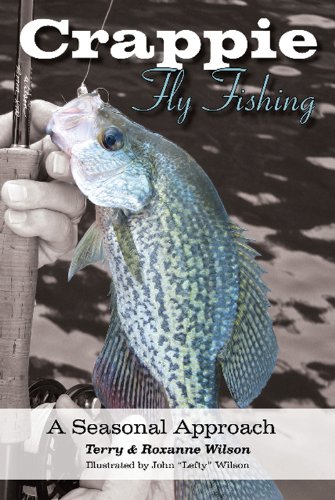
White crappie [Pomoxis annularis] are morphologically similar to black crappies [Pomoxis nigromaculatus]. Photo by Hammil US Army COE, a commons image.
On a 3/4 weight forgiving rod it doesn’t get any better
By Skip Clement
[dropcap]C[/dropcap]rappie and their so-called cousins, panfish, have benefactors and they understand how to catch them in all weather, water and climates. Their book, Crappie Fly Fishing, has been around for a few years. It is so good that an expert or novice angler will find angling for these little pescados rewarding from the get-go.
While fly fishers have historically scoffed at many of the warm water species, today, more and more are discovering the excitement these fish offer. All you’ll need to do is give crappies a try, and you are apt to be a fan for life. But before you go, you ought to get a copy of the Terry and Roxanne Wilson’s new book, Crappie Fly Fishing. The book has universal appeal because crappies can be found almost anywhere in the United States. Too, they have a voracious attack mentality, and on a 3-weight you’re in for a tussle.

Crappie [sunfish] has more colloquially reserved names than a check forger. “Pancakes” come to mind as one of the funnier ones. No matter the regional name, they lay claim to having devotees in both fly fishing and spin fishing camps with magazines, books, and bloggers to support addictions. No matter the favored way to fish for them, they are good to eat, but should never be caught in great numbers merely to pose and boast at the dock, unless, of course, psychologically unfit and needy of undeserved recognition.
The Wilson’s have collaborated on three priors books: Bluegill Fly Fishing & Flies, Largemouth Fly Fishing, and Smallmouth Bass Fly Fishing. The fourth book titled Crappie Fly Fishing is another on the money road map of “how-to” catch crappies on a fly. In their concise and highly entertaining style, the Wilson’s take readers year-round by season and explain the behaviors and habitats, the most effective equipment, when, where and how to find and catch them, as well as best flies and fly styles, including fly-tying steps and more.
The Wilsons have presented innovative, practical fly-fishing methods for bass, bluegill, crappie, gar, and channel catfish for more than twenty years in over a hundred magazine articles published in Fly-Fishing and Tying Journal, The Flyfisher, Midwest Fly-Fishing, Warmwater Fly-Fishing, Fly-Fishing Quarterly, BassMaster Magazine, Ontario Out of Doors, and many others. They are also staff writers for St. Louis-based Outdoor Guide Magazine.

Terry Wilson’s Bully’s Bluegill Spider Fly.
Terry and Roxanne are members of the Missouri Smallmouth Alliance and are active life members of the Federation of Fly Fishers. They were presented with the Federation’s Don Harger Memorial award in 1996 for their contributions to the sport of fly fishing. Roxanne was named 1994 Woman of the Year by the Federation’s Southern Council. They are also members of the Federation’s Warmwater Conservation Committee.
Terry’s original flies for bluegills, largemouth bass, and smallmouth bass have been featured in Fly Fish America, Fly-Fishing and Tying Journal, and the Federation of Fly Fishers Magazine. One of his best-known flies is the “Bully’s Bluegill Spider.
[information]
To purchase: Call your local fly shop or Amazon
[/information]

